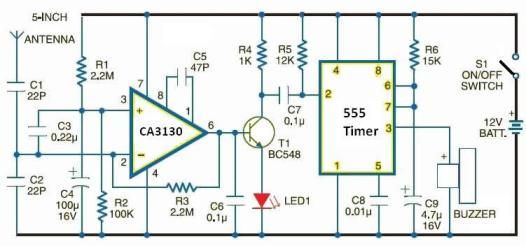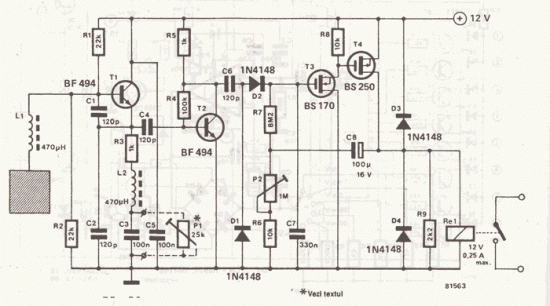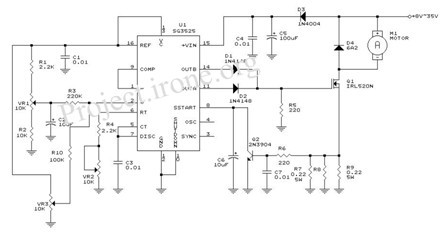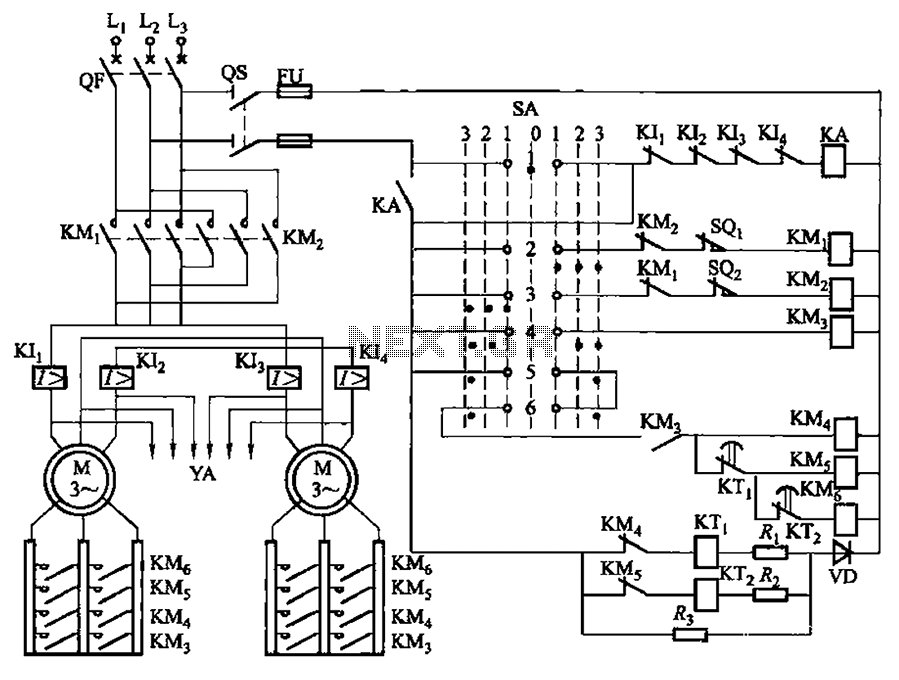
Cellular phone detector circuit schematic

This electronic schematic can be used to design a simple cellular phone detector circuit capable of sensing the presence of an activated mobile phone from a distance of approximately 1.5 meters. The C3 capacitor should have lead lengths of 18 mm with an 8 mm spacing between the leads to achieve the desired frequency. This small disk capacitor functions as a gigahertz loop antenna for collecting RF signals.
The cellular phone detector circuit is primarily composed of a few essential components, including the C3 capacitor, which serves a dual purpose: it not only filters signals but also acts as a loop antenna to capture radio frequency (RF) emissions from nearby mobile phones. The circuit operates by detecting the electromagnetic waves emitted by mobile phones when they are in use or in standby mode.
To optimize performance, the capacitor's lead length and spacing are crucial. The specified dimensions of 18 mm for lead length and 8 mm for spacing are designed to resonate at the typical frequency range of mobile phone signals, which is generally between 900 MHz and 1800 MHz, depending on the network technology (GSM, CDMA, etc.).
In addition to the capacitor, the circuit may include a transistor or an operational amplifier to amplify the detected signals. A simple LED indicator can be integrated into the circuit to provide a visual indication of detection. When the circuit detects RF signals from a mobile phone, the amplified output can trigger the LED to illuminate, signaling the presence of an active phone.
Furthermore, the entire circuit can be powered by a small battery or a DC power supply, ensuring portability and ease of use. Proper grounding and shielding techniques should be employed to minimize interference from other electronic devices. The layout of the circuit should also consider the placement of components to maximize sensitivity and minimize noise.
Overall, this cellular phone detector circuit represents a straightforward yet effective application of RF technology, suitable for various practical uses, such as security systems, privacy applications, or educational demonstrations in electronics.Using this electronic schematic, can be designed a very simple cellular phone detector circuit which can sense the presence of an activated mobile cell phone from a distance of one and-a-half meters. The C3 capacitor must have leads length of 18 mm with 8 mm spacing between leads to obtain the desired frequency.
This small disk capacitor acts as a small gigahertz loop antenna to collect the RF signals. 🔗 External reference
The cellular phone detector circuit is primarily composed of a few essential components, including the C3 capacitor, which serves a dual purpose: it not only filters signals but also acts as a loop antenna to capture radio frequency (RF) emissions from nearby mobile phones. The circuit operates by detecting the electromagnetic waves emitted by mobile phones when they are in use or in standby mode.
To optimize performance, the capacitor's lead length and spacing are crucial. The specified dimensions of 18 mm for lead length and 8 mm for spacing are designed to resonate at the typical frequency range of mobile phone signals, which is generally between 900 MHz and 1800 MHz, depending on the network technology (GSM, CDMA, etc.).
In addition to the capacitor, the circuit may include a transistor or an operational amplifier to amplify the detected signals. A simple LED indicator can be integrated into the circuit to provide a visual indication of detection. When the circuit detects RF signals from a mobile phone, the amplified output can trigger the LED to illuminate, signaling the presence of an active phone.
Furthermore, the entire circuit can be powered by a small battery or a DC power supply, ensuring portability and ease of use. Proper grounding and shielding techniques should be employed to minimize interference from other electronic devices. The layout of the circuit should also consider the placement of components to maximize sensitivity and minimize noise.
Overall, this cellular phone detector circuit represents a straightforward yet effective application of RF technology, suitable for various practical uses, such as security systems, privacy applications, or educational demonstrations in electronics.Using this electronic schematic, can be designed a very simple cellular phone detector circuit which can sense the presence of an activated mobile cell phone from a distance of one and-a-half meters. The C3 capacitor must have leads length of 18 mm with 8 mm spacing between leads to obtain the desired frequency.
This small disk capacitor acts as a small gigahertz loop antenna to collect the RF signals. 🔗 External reference





